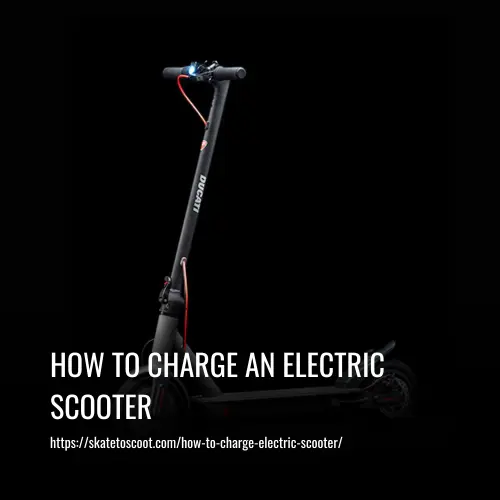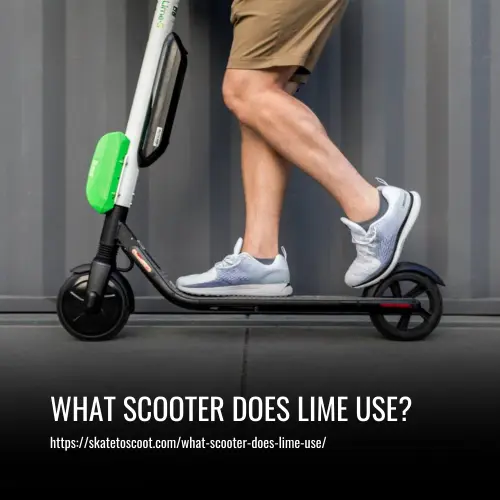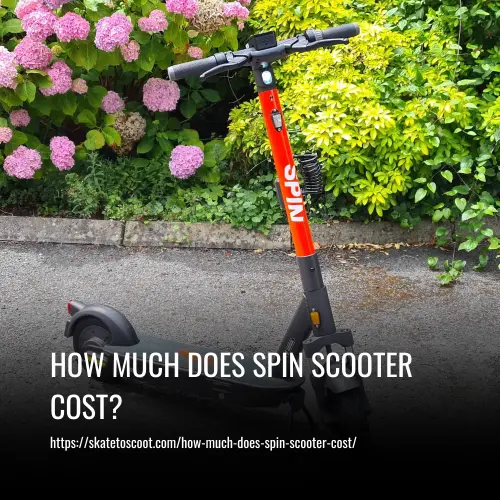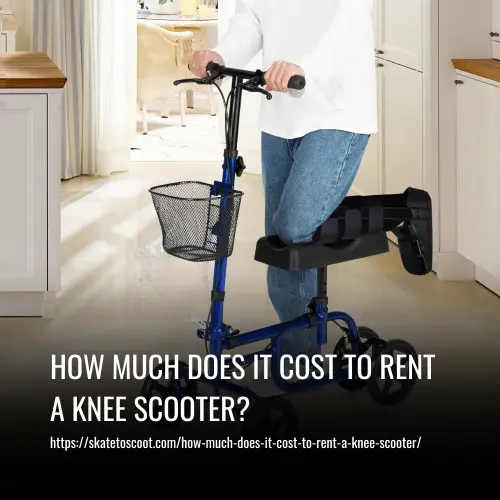As an Amazon Associate we earn from qualifying purchases.
Charging an electric scooter is a crucial aspect of owning and maintaining it. Just like with any electronic device, understanding the charging process and taking proper care of the battery is essential for maximizing its lifespan and ensuring optimal performance.
In this article, we will guide you through the steps to effectively charge your electric scooter. From battery levels and types to the correct charger and charging port, we’ll cover everything you need to know.
Whether you have a scooter with lithium-ion batteries or lead-acid batteries, understanding the charging process will help you avoid battery damage and extend its longevity. So, let’s dive in and learn how to charge your electric scooter the proper way, ensuring you’re always ready for your next ride.

How To Charge an Electric Scooter: Step-by-Step Guide
Charging your electric scooter properly is important to ensure an optimal charge cycle and prevent damage to the charger or battery. Follow these step-by-step instructions to charge your electric scooter correctly:
1. Plug the Charger into a Power Outlet
Begin by plugging the charger into a power outlet before connecting it to your electric scooter. This prevents any discharge of current from the charger into the battery and avoids potential damage caused by sparking.
2. Connect the Charger to the Scooter’s Charging Port
With the charger securely plugged into the power outlet, connect the other end to your scooter’s charging port. Ensure that the scooter is switched off before plugging in the charger. If there are any protective covers on the charging port, remove them and check for any dust or debris before connecting the charger.
3. Check for a Red Light on the Charger
Once the charger is connected to the scooter, check for a small red LED charging light on the charger. This indicates that the charger is connected correctly, and the charging process has begun.
4. Wait for Your Scooter to Charge
Allow the scooter to charge until it reaches your desired level. Refer to your scooter’s user manual for an estimated charge time or use a simple equation to determine the charge time.
5. Turn the Charger Off and Disconnect It When a Green Light Shows
When the red light on the charger turns green, it indicates that the battery is fully charged. For scooters without battery management systems, it is advised to stop charging at around 80% or immediately unplug the charger once it turns green, as overcharging can degrade battery life.
By following these steps, you can ensure proper charging of your electric scooter and extend the longevity of your battery. Remember to always use the correct charger provided with your scooter and avoid exposing the scooter to extreme temperatures during charging.
How to Find the Correct Charger For Your Scooter
To find the correct charger for your electric scooter, it is best to purchase one directly from the manufacturer or retailer. However, if that is not an option, there are some useful tips to help you choose the right charger.
First, ensure that the voltage of the charger matches the voltage of your scooter’s battery. The amperage can either match the standard charger or be higher for faster charging. Using a charger with incorrect voltage or amperage can lead to failed recharges and battery damage.
As a general rule, fast chargers should only be used on batteries with capacities exceeding 15Ah, with a maximum amperage of 4A. Additionally, check that the charger’s connector matches your scooter’s charging port, as different scooters use different connectors such as GX16-3P, M16-3P, XLR, XT60, DC Coaxial, or USB.
How To Charge Electric Scooter Without Charger
If you find yourself without a charger for your electric scooter, it is best to wait until you can obtain the correct charger. However, in emergencies, there is a procedure that can be followed using a car battery as an alternate power source.
First, turn off your scooter and disconnect the battery. Identify the positive (red) and negative (black) terminals on the battery. With the help of jumper cables, connect the positive terminal of the scooter battery to the positive terminal of the car battery, and the negative terminal of the scooter battery to a grounding point on the car or another metal surface.
Start the car and let the scooter battery charge for a while. When finished, disconnect the jumper cables in the reverse order, ensuring that the leads never touch each other. Please note that this should only be done in emergencies, as it is best to use the designated charger for optimal battery life and safety.
How Long To Charge An Electric Scooter
The charging time for an electric scooter depends on the model, battery size, and type of charger. It is important to consult the instruction manual for specific charging information. On average, it takes between 3 to 5 hours to fully charge an electric scooter with a standard charger.
If the charging time exceeds 8 hours, it is recommended to charge the scooter overnight. While fast chargers can fill up the battery in less than an hour, they should be used sparingly. It is important to follow the manufacturer’s guidelines to ensure proper charging and avoid any potential battery damage.
Charge Time Table (Based on Popular Battery Sizes & Charge Rates)
| Battery (Ah) | 1A | 2A | 3A | 4A |
|---|---|---|---|---|
| 5.2 Ah | 5.2 hr | 2.6 hr | 1.7 hr | 1.3 hr |
| 7.5 Ah | 7.5 hr | 3.75 hr | >2.5 hr | 1.9 hr |
| 10.4 Ah | 10.4 hr | 5.2 hr | 3.5 hr | 2.6 hr |
| 13 Ah | 13 hr | 6.5 hr | 4.3 hr | 3.3 hr |
| 15.6 Ah | 15.6 hr | 7.8 hr | 5.2 hr | 3.9 hr |
| 18.2 Ah | 18.2 hr | 9.1 hr | 6.1 hr | 4.6 hr |
| 20.8 Ah | 20.8 hr | 10.4 hr | 6.9 hr | 5.2 hr |
| 23.4 Ah | 23.4 hr | 11.7 hr | 7.8 hr | >5.9 hr |
| 24.5 Ah | 24.5 hr | 12.25 hr | 8.2 hr | 6.1 hr |
| 28 Ah | 28 hr | 14 hr | 9.3 hr | 7 hr |
| 30 Ah | 30 hr | 15 hr | 10 hr | 7.5 hr |
| 32 Ah | 32 hr | 16 hr | 10.7 hr | 8 hr |
| 35 Ah | 35 hr | 17.5 hr | 11.7 hr | 8.8 hr |
Use this table to estimate how long it will take to charge your battery from 0 to 100%.
How Often To Charge An Electric Scooter
To ensure optimal performance and battery longevity, it is recommended to charge an electric scooter overnight after each day of use, especially if you ride it regularly. Ideally, you should refrain from letting the battery level drop below 30% as lithium-ion batteries tend to perform less effectively at this level.
Regularly depleting the battery below this threshold can result in decreased performance and a shortened battery lifespan. Following these guidelines will help maintain the efficiency and longevity of your electric scooter’s battery.
How Much Does It Cost to Charge an Electric Scooter
To calculate the cost of charging an electric scooter, you need to know the watt-hour (Wh) value of your scooter’s battery. This is calculated by multiplying the battery’s voltage (V) by its amp-hours (Ah). For example, if the battery is 36V and 10Ah, the Wh value would be 360Wh. Then, divide the Wh figure by 1,000 to get the kilowatt-hour (kWh) value, which in this case would be 0.36 kWh.
Finally, multiply the kWh value by your local electricity rate to get the cost. The average residential electricity rate in the U.S. is 15.46 cents per kilowatt-hour. Therefore, it would cost just $0.06 to charge an electric scooter with a 36V 10Ah battery, which provides 25-30 miles of ride time.
Standard and fast electric scooter chargers cost between $40 and $180.
| Regular Chargers | Cost |
|---|---|
| 36V | $40 |
| 48V | $79 |
| 52V | $79 |
| 60V | $89 |
| 72V | $89 |
| Fast Chargers | Cost |
|---|---|
| 36V | N/A |
| 48V | $129 |
| 52V | $129 |
| 60V | $139 |
| 72V | $179 |
How Far Can Electric Scooter Go On One Charge
The range of an electric scooter on a single charge varies depending on the scooter and battery type. Some scooters can travel up to 75 miles on a single charge, thanks to more efficient and longer-lasting batteries. However, factors like speed, rider weight, battery life, riding surface, weather conditions, and elevation can affect the scooter’s range.
Heavier riders and scooters with shorter battery life tend to cover shorter distances. Additionally, rough and hilly terrain requires more power, reducing the scooter’s range. On average, mid-range electric scooters offer a range of 35 to 40 miles on a single charge.
What To Do When Electric Scooter Won’t Charge
If your electric scooter won’t charge, try troubleshooting the issue by following these steps:
1. Check the battery’s history and inspect it for any unusual signs such as a strange smell, swelling, or physical damage. This can help determine if the battery needs to be replaced.
2. Test the charger’s output voltage using a voltmeter to ensure it is providing the correct power supply to the scooter. If the output voltage is not within the appropriate range, consider getting a new charger.
3. Pay attention to the battery’s temperature. Extreme temperatures can affect its performance, so ensure it is not too hot or too cold.
4. If you have tried all the troubleshooting steps and still can’t resolve the issue, it is recommended to take your electric scooter to a professional for further examination and repair.
Keep in mind that opening up your scooter to fix the problem yourself is not recommended unless you have experience with scooter repair. It is best to seek professional assistance for complex issues to avoid causing further damage.
Electric Scooter Charging Tips
To ensure optimal performance and prolong the battery life of your electric scooter, follow these charging tips:
1. Utilize the 80/30 Rule
For older batteries, particularly those made of metal hydroxides, consider employing the 80/30 charging rule. This means never letting your battery drop below 30% and only charging it up to 80%. This technique can significantly slow the rate of battery degradation and extend its lifespan. However, modern electric scooters with lithium-ion batteries and controllers are calibrated to prevent over-voltage, low-voltage, and over-discharge.
2. Avoid Fast Charging
While fast charging may be convenient, it can lead to increased heat generation and accelerated battery degradation. If you opt for a fast charger, make sure not to exceed a charge rate of 4A. It is generally recommended to use the charger that comes with your scooter for optimal charging.
3. Use Consistent Chargers
If you have both a standard charger and a fast charger, choose one type and stick with it. Avoid alternating between different chargers or using fast and standard chargers simultaneously, especially in scooters with dual charging ports.
4. Prevent Overcharging
Once your battery reaches 100% charge, disconnect the charger immediately to prevent overcharging. Although chargers, batteries, and controllers typically have protective measures in place, it is still advisable to unplug following a charge in case of any failures that could lead to permanent damage.
5. Charge in Suitable Temperature Range
Charge your electric scooter’s battery within a temperature range of 32°F to 113°F (0°C to 45°C). Extreme temperatures can negatively impact the chemical reactions within the battery, so it’s essential to charge within this recommended range to minimize degradation risk.
6. Storage Recommendations
When storing your scooter, keep the battery at around 40% charge. Fully discharging the battery or leaving it at 0% charge for an extended period can accelerate degradation. Additionally, store the scooter in a cool, dry environment to protect against temperature fluctuations and moisture damage.
7. Ensure Dryness
Before charging, make sure both the electric scooter and charger are dry to avoid short circuits, fire hazards, and electric shock. Dry any wet parts, including the battery port, before connecting them for charging.
8. Turn Off the Scooter
To ensure proper charging, always turn off the scooter while charging. If left turned on, the battery may simultaneously discharge power to the scooter’s electrical components, leading to faulty charging and potential battery damage.
By following these tips, you can maximize the performance and longevity of your electric scooter’s battery.
FAQs
To determine if your electric scooter is charging, check for an indicator light. Most scooters have a battery or charging status indicator light that turns on when the scooter is being charged. This light is usually located near the charging port or on the scooter’s handlebar. When you plug in the charger, the light should turn on, indicating that the scooter is receiving power.
The most common battery type used in electric scooters is lithium-ion (Li-ion). Li-ion batteries are preferred due to their energy density, longer lifespan, and lighter weight compared to other battery types. They also have a lower self-discharge rate and can be charged more frequently without affecting their overall capacity.
It is recommended to charge your electric scooter when the battery level is between 20-30%. This helps maintain the battery’s health and prolong its lifespan. Avoid waiting until the battery is completely drained before charging, as it can lead to performance issues and decrease battery longevity.
When your electric scooter is fully charged, the battery indicator light on the scooter or charger will typically turn green. This indicates that the battery has reached its maximum capacity and is ready for use.
It is not necessary to charge your electric scooter after every ride. Charging frequency depends on the scooter’s battery capacity, usage, and personal preferences. However, it is advisable to charge the scooter regularly to maintain a healthy battery.
No, you don’t always need to charge your electric scooter fully. Lithium-ion batteries, commonly used in electric scooters, do not require a full charge every time. Partial charges can be beneficial for battery longevity.
The duration of an electric scooter charge depends on various factors such as battery capacity, scooter model, speed, terrain, and weather conditions. On average, electric scooters can provide a range of 15-30 miles on a single charge.
Most electric scooters come with built-in protection mechanisms to prevent overcharging. Once the battery is fully charged, the charger will automatically stop supplying power, eliminating the risk of overcharging. However, it is still recommended to unplug the charger once the scooter is fully charged to optimize battery life.
Charging an electric scooter overnight is generally safe. However, it is advisable to check the manufacturer’s instructions and recommendations, as some scooters may have specific charging time guidelines to ensure optimum battery performance.
Yes, electric scooters can be charged at home using a standard power outlet. Just make sure to use a charger that is compatible with your scooter and follow the correct charging procedure.
The charging time for an electric scooter battery can vary based on factors such as battery capacity and charger amperage. It typically takes a few hours to fully charge a scooter battery.
There could be several reasons why your scooter is not charging, including a faulty charger, a damaged charging port, or a problem with the battery or electrical system. It is recommended to check all connections and consult the scooter’s manufacturer or a professional for troubleshooting assistance.
Plugging the charger into the wall first before connecting it to the scooter is a safety measure to avoid potential electrical sparks or short circuits. This ensures a stable power supply and minimizes the risk of damage to the scooter’s charging port or battery.
Leaving your scooter plugged in after it has fully charged can potentially damage the battery. Overcharging can lead to decreased battery performance and even shorten its overall lifespan. It is recommended to unplug the scooter once it has reached a full charge to keep the battery in optimal condition.
Most electric scooters use a standard charger that is specifically designed for their battery type. The most common type of battery used in electric scooters is a lithium-ion battery. It is important to use the correct charger that matches the battery type to ensure safe and efficient charging.
No, electric scooter chargers are not universal. Different electric scooter models may require different chargers that are specifically designed for their battery voltage, capacity, and charging port. It is crucial to use the original charger provided by the manufacturer or a compatible charger to avoid potential damage to the battery.
Typically, electric scooter batteries can endure hundreds to thousands of charge cycles before their performance starts to degrade. The exact number of charge cycles can vary depending on various factors such as battery type, usage patterns, and maintenance practices. Lithium-ion batteries commonly used in electric scooters can last around 300-500 charge cycles.
The charging port on an electric scooter is usually located on the scooter’s frame or near the deck. It is essential to familiarize yourself with the scooter’s design to locate the charging port. Refer to the user manual or manufacturer’s guidelines for the exact location of the charging port on your specific scooter model.
Overcharging an electric scooter can lead to increased heat buildup within the battery, which can cause battery damage, reduced performance, or even pose a safety risk. It is crucial to monitor the charging process and unplug the scooter once it has reached a full charge.
Charging an electric scooter with a power bank is not recommended. Power banks usually do not provide enough voltage or output capacity required for efficient charging of electric scooters. It is best to use a dedicated scooter charger and connect it to a power outlet for proper charging.
Some electric scooter-sharing companies, such as Bird and Lime, offer opportunities for individuals to earn money by charging their scooters overnight and then dropping them off at designated locations the next day. This allows the scooters to be fully charged and ready for use for the next customers. Check with local scooter-sharing companies to see if they offer such opportunities in your area.
Fast chargers are specifically designed for certain battery types and may not be suitable for all electric scooter batteries. Different batteries have different voltage and capacity requirements, so it is important to use the charger recommended by the manufacturer or one that is compatible with your scooter’s battery type to avoid damaging the battery.
To calculate the charge time for your electric scooter, you need to know the battery capacity and the charger’s output voltage and current. Divide the battery capacity by the charger’s output current to determine the charge time in hours. For example, if your scooter’s battery capacity is 10Ah and the charger’s output current is 2A, the charge time would be approximately 5 hours (10Ah ÷ 2A = 5 hours).
To charge an electric scooter battery, plug it into a power outlet. This can be done at home or while you’re out. The charger will start the charging process automatically. Once the battery is fully charged, a green light will indicate that it’s ready to use.
Charging an electric scooter does not consume a significant amount of electricity. In fact, it only consumes a small amount of electricity per charge, so you don’t have to worry about your electricity bill increasing dramatically. The amount of electricity an electric scooter consumes is likely less than what you already pay for your electricity bill.
Yes, electric scooter batteries are generally safe to use. While they are lithium-ion batteries, which can pose a fire hazard if exposed to high temperatures or currents, they have been tested and approved for usage. Additionally, there is a battery management system in place to prevent overheating and incorrect charging. However, it is still important to handle and store the batteries properly to ensure safety.
Conclusion
In conclusion, properly charging your electric scooter is crucial for maintaining its battery life and ensuring a smooth ride. Using the correct charger and charging port, monitoring the battery levels, and allowing the scooter to charge fully are essential steps. Lithium-ion batteries, which are commonly used in electric scooters, require special care to prevent damage.
It is important to avoid extreme temperatures and use the original charger or a compatible one. The indicator light, often green, will indicate when the scooter is fully charged. Remember to disconnect the charger and always use a power outlet and power supply that is safe and appropriate for charging your scooter.
Charging your electric scooter correctly will not only extend its battery longevity but also save you money on electricity costs. So, follow these guidelines and enjoy your electric scooter for years to come.
Amazon and the Amazon logo are trademarks of Amazon.com, Inc, or its affiliates.



